How to deal with cockroaches in restaurant kitchens and how to get rid of them fast.
Cockroaches in restaurant kitchens find food, shelter and water. Their requirements are handsomely met. In the wee hours, when cockroaches are active, commercial kitchens are quiet and dark. For them, a restaurant kitchen is a paradise found.
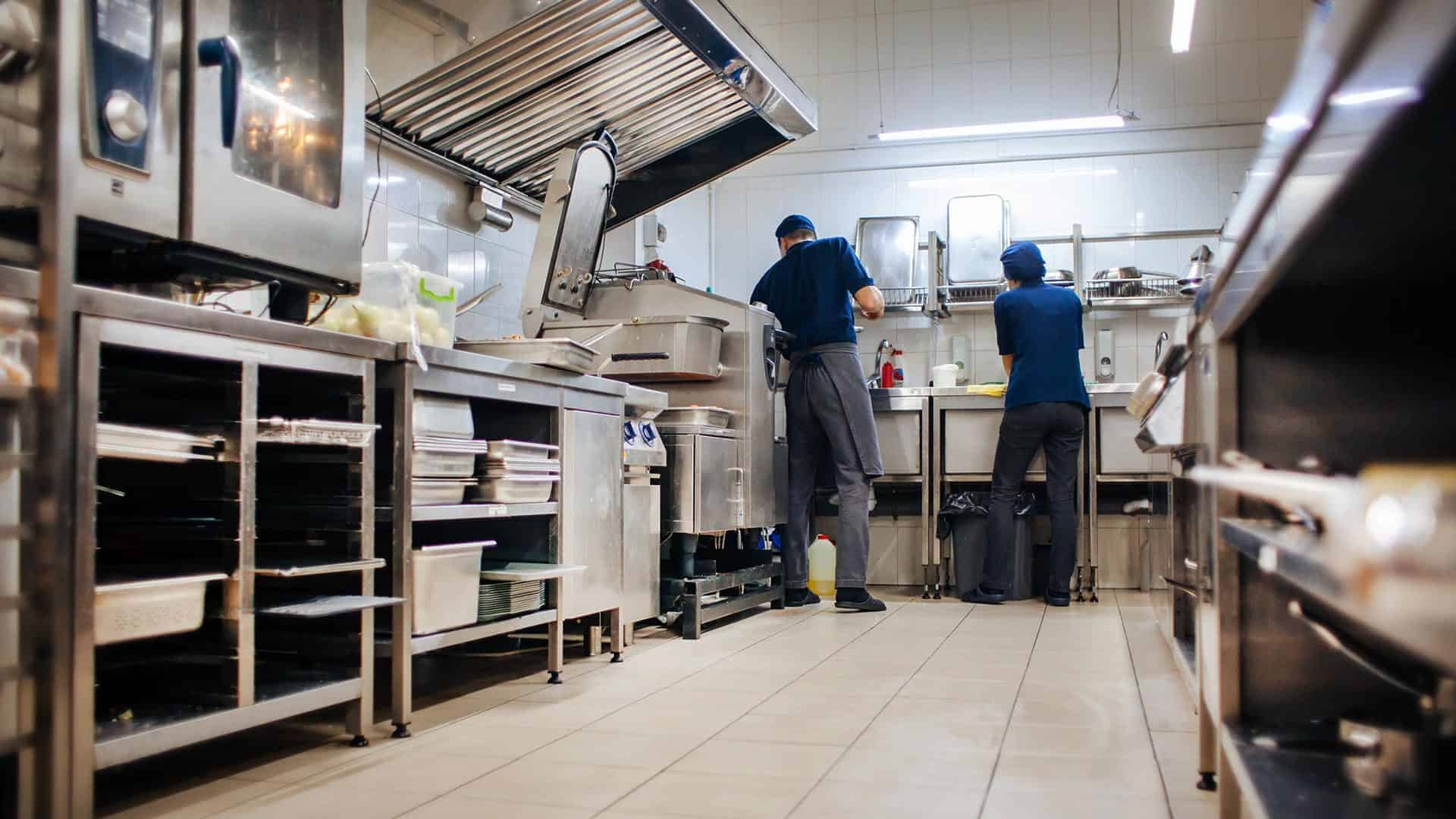
Why are cockroaches a problem for restaurant kitchens?
- Cockroaches contaminate food with bacteria causing food poisoning.
- They transmit diseases including hepatitis, salmonella and gastro.
- Certain proteins they carry cause allergic reactions, known to trigger asthma symptoms.
- Cockroaches leave a trail of faeces, saliva and body parts.
- They scamper from drains and rot across kitchen surfaces and implements.
- They gnaw through packaging, spoiling food products.
- Cockroaches reproduce rapidly. A few individuals can quickly lead to an infestation. The threshold for any cockroach species is 0. Finding even one specimen warrants control action.
Cockroaches live in groups called aggregations. They begin life as an egg. These eggs are not easily affected by insecticides. Cockroaches are good climbers. They taste their food before eating it, and they learn to avoid chemically treated surfaces.
It’s much easier to prevent a cockroach issue than remove one. Stay on top of your preventative procedures.
How do restaurants become cockroach infested?
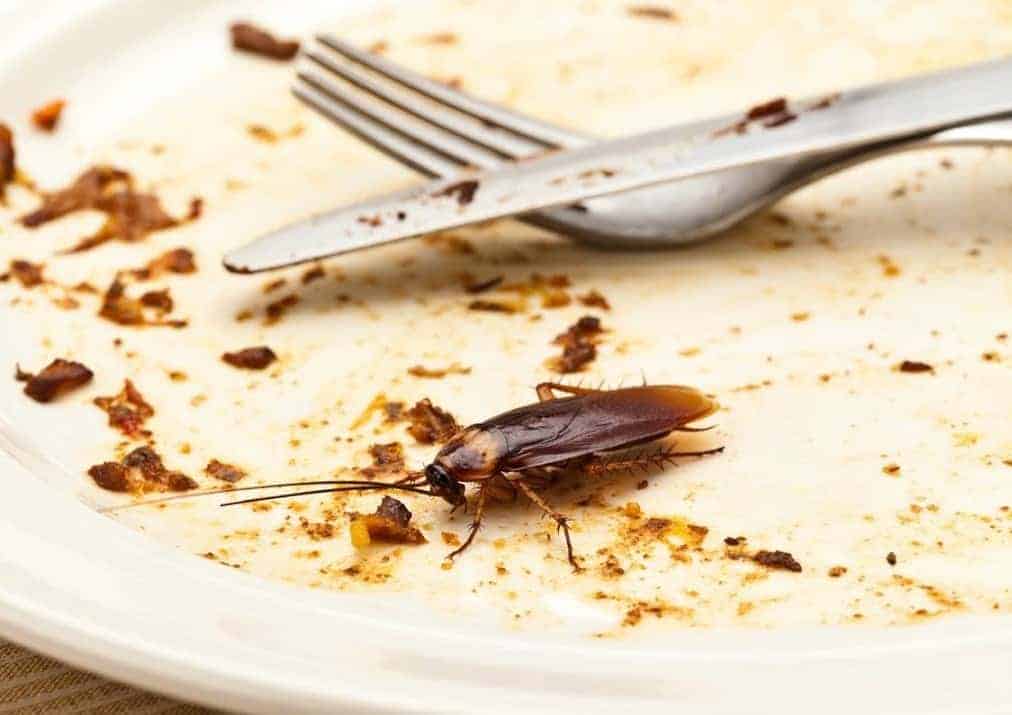
Cockroach in restaurant
Poor food storage
Poor food storage leads to cockroach infestations. Food items must be stored in sealed containers or insect-proof areas.
Poor procedure
Cockroaches eat everything including grease particles. Restaurant kitchens must be left spotless. Cockroaches will eat animal and vegetable matter, starches, grease particles, paper, cardboard, leather and fabric.
Dirty dishes and surfaces
Cockroaches are attracted to dirty surfaces and dishes. Dirty dishes make a meal for an aggregation of cockroaches.
Maintenance and cleaning not enforced
Spills, messes and dirty staff areas can attract cockroaches. Include staff areas on cleaning schedule and always make staff clean spills and mess as they go.
Lack of reporting
Ensure your staff know what to do when they sight a cockroach. Who do they tell? Do you have a pest sighting register? Do they know where to make a note of it? Is there something they can do about it? Does the kitchen have a spray or a sticky trap staff can put out and mark on a kitchen trap site map?
Standing water
Water on the ground is not usually looked at as a cleanliness issue but standing water can be a big attraction for cockroaches. While they can survive for up to a month without food, cockroaches can only live a week without water. For this reason, leakage from pipes or taps needs to be fixed and kitchen floors must be clean and dry at the end of the night. Water caught in cracked tiles and under equipment should be removed. Good ventilation is helpful to avoid moist areas developing in service and bar spaces throughout the restaurant.
Shelter
Many species of cockroaches will go to great lengths to enter a building that is warm and humid. To combat this, close off all entry points. Look for holes or cracks around windows and door frames, water pipes, and baseboards. Use inexpensive silicone caulk to seal them up. Stainless steel wool scourers are ideal for stuffing around pipes in cupboards. Big W sells a ten pack for $4. Ensure screen doors fit securely inside their frames. Consider putting a draught stopper on your back door to stop cockroaches walking inside, under the door, at night.
Cockroaches in your deliveries
Ensure employees are inspecting deliveries for signs of cockroaches. Try not to bring cardboard into the kitchen. If you must, have goods repacked into plastic storage tubs and get rid of the cardboard. German cockroaches love travelling and laying eggs in cardboard. Establish a designated quarantine area outside. If cockroach activity is found on incoming goods, move the goods outside into the quarantine area immediately. You may wish to contact the supplier and inform them of their pest problem.
Attracted to your rubbish areas
Keep all bins and dumpsters clean, lids closed and do not over fill. Ensure a sealed bagged policy for all waste. Keep rubbish bins as far from your back door as possible. If you can keep them in the shade – this will also help minimise fly control problems. Download your copy of the fly control checklist here.
Steel wool and draught stoppers assist in keeping cockroaches out of your kitchen.
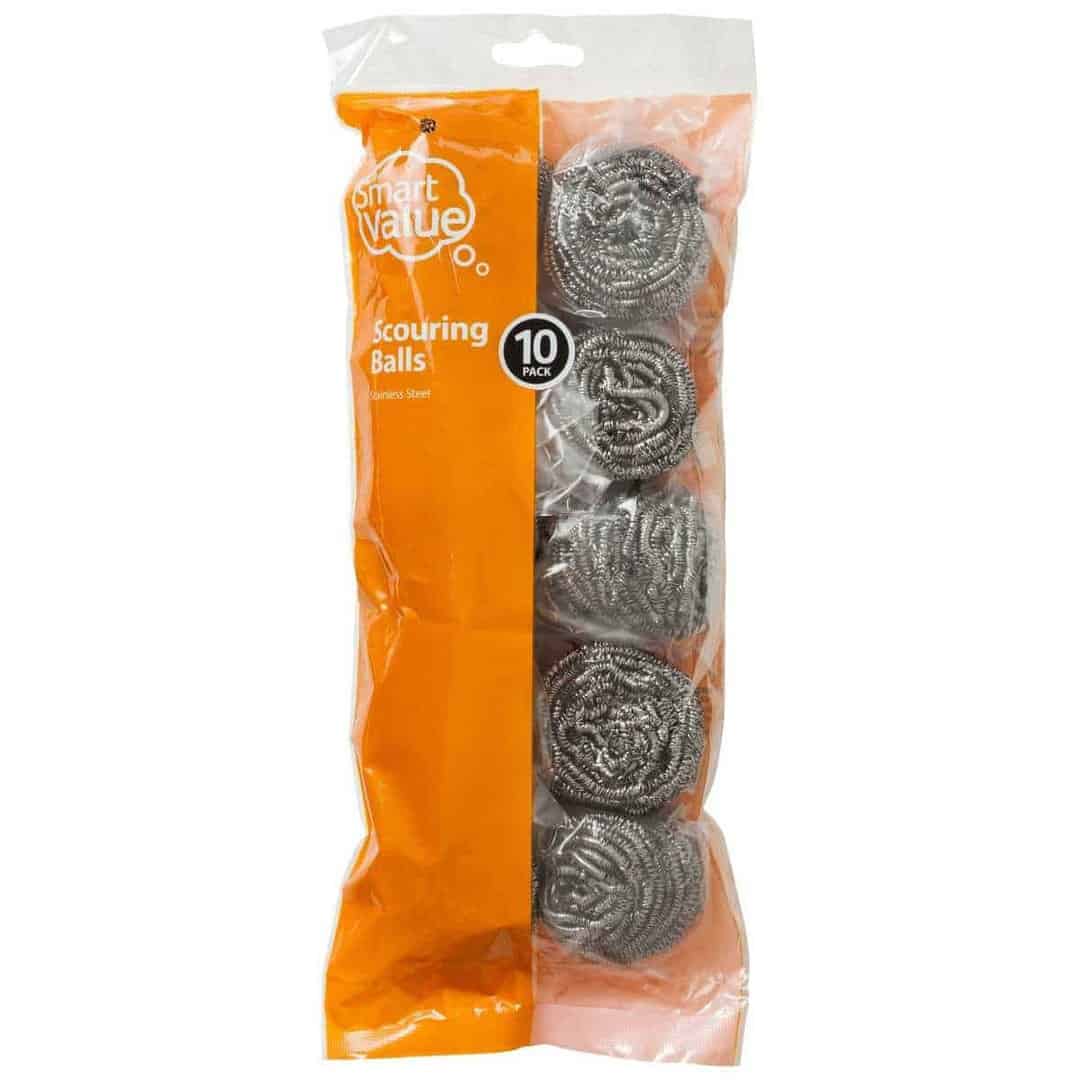
Steel wool
Fill gaps around plumbing coming through the walls into your kitchen, such as pipes below sinks and hand basins.
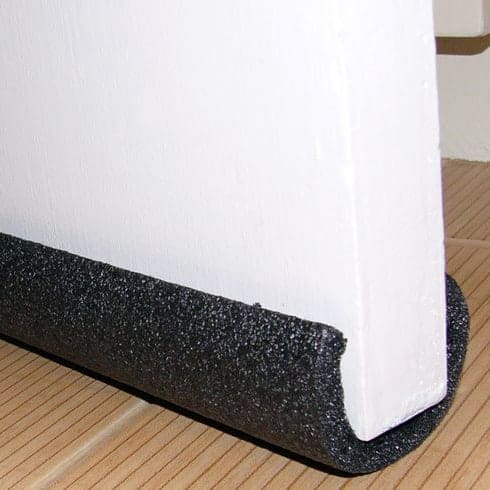
Draught stopper
A draught stopper on your back door will help keep cockroaches out. There are many kinds available. Bunning Warehouse sell them.
What are the tell-tale signs of cockroaches in a restaurant kitchen?
- Dropping: Small, black in colour and appear like ground coffee. Cockroaches press or smear their droppings onto surfaces to mark feeding and grouping or aggregation sites.
Researchers investigated the gut bacteria of cockroaches and its ability to produce aggregation-inducing pheromones. Read their article “Gut Bacteria Help Cockroaches Communicate.” Read here.
- Smear marks: If water is abundant, then the cockroaches will produce irregular shaped brown smear marks as they rest or crawl from one place to another.
- Egg capsules: Eggs are laid in a capsule known as ootheca. These discarded capsules are dark brown and about the size of a coffee bean.
- Shed skin: while maturing into an adult, a cockroach sheds its skin 6-7 times. These fragments of exoskeletons are signs of the next lot of breeders coming through.
- Damaged Items: Cockroaches are scavengers and have wide-ranging tastes. Gnaw marks maybe found in paper products, cloth items, leather, cardboard and food stuffs.
- Unusual odour: Cockroaches produce a pheromone while defecating. This pheromone signals cockroaches to congregate. This smell is a musky odour to humans and taints items that it contacts.
- Scuttling cockroaches: Cockroaches are champion hiders, occasionally seen scuttling from their cracks and crevice’s across open spaces. A Blundstone boot is a sure way to kill a cockroach. Squishing a female carrying an egg case may result in you dispersing eggs throughout the restaurant, via the sole of your shoe
Cockroach in restaurant
Fossil records show cockroaches have changed little in 200 million years. Of the 4600 cockroach species, 30 are associated with human habitats. Distributed worldwide by commercial activity, cockroaches are found throughout the tropics and sub tropics.
Some species including German cockroaches, have elaborate social structures involving common shelter, social dependence, information transfer and kin recognition.
Cockroaches are able to compact their bodies. Young cockroaches can squeeze through tiny holes. A juvenile German cockroach can crawl into a power point. Cockroaches squeeze their way into restaurants. Once inside they can make their way, room to room via the wall voids. If you see a cockroach during the day, it is likely there are more at night.
The German or kitchen cockroach
Scientific name: Blatella germanica.
Adult size: 13-16mm
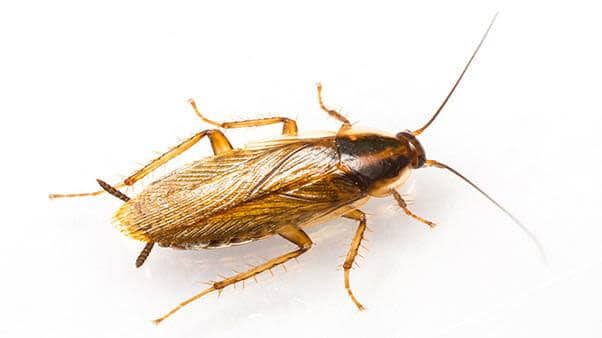
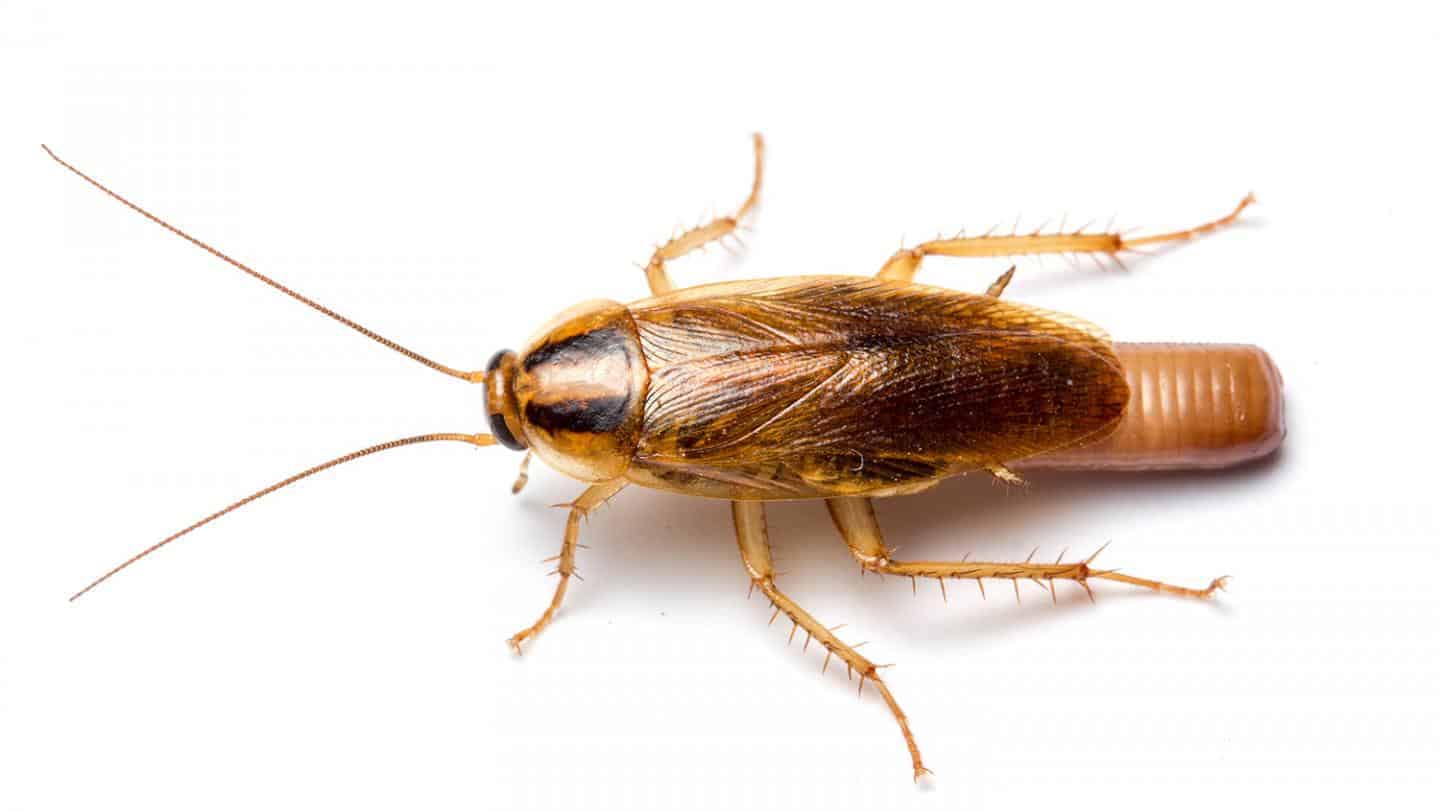
The adult is light brown in colour with two dark almost parallel longitudinal stripes on their shield.
They are thought to have originated in East and South East Asia and are the most common cockroach pest in buildings worldwide. Maintained by heating systems in cooler climates, they are rarely found outdoors. Their temperature preference is 20–27°C.
Being smaller than other common cockroaches they able to live and breed in the cracks and crevices found throughout buildings but show a preference for warm humid areas. Restaurant kitchens and food storage areas are ideal. German cockroaches can climb vertical glass or tiled surfaces.
When looking for German cockroaches check behind and under ovens, sinks, equipment engines and around water pipes. Pay special attention to where pipes pass through walls and inside cupboards, under tables, behind wall tiles, notice boards, ventilation and service ducts. Remember to check the power points.
The ootheca, containing 35-40 eggs, is carried by the female until it is within one to two days of hatching. When nymphs emerge, they squeeze into tiny cracks and crevices in the immediate area. The nymphs mature into adults in 6 – 10 weeks.
American cockroach or largest cockroach
Scientific name: Periplaneta americana.
Adult size: 34-53mm
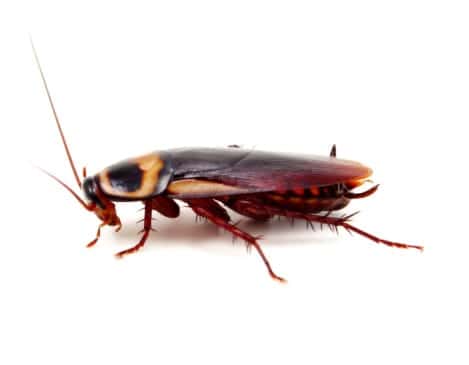
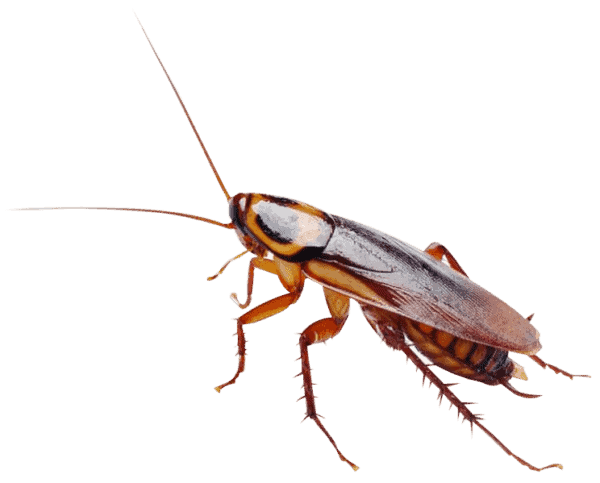
The adult is reddish brown in colour and is fully winged. Male wings extend beyond the tip of the abdomen; female wings do not. There is a pale brown to yellowish band around the edges of the pronotum. It is relatively slow growing reaching maturity in 6 to 12 months. There are fewer generations per year than the German cockroach and infestations are slower to build up.
These cockroaches find fewer places to hide in restaurant kitchens because of the large size of both adults and nymphs. They are generally found in wall voids, behind cupboards, in underfloor areas or roof spaces, basements, storage rooms and waste storage areas.
American cockroaches can also live outside buildings in areas including gardens, around garbage, inside drains and in out-houses such as sheds or garages. They can be common in sewers and sewer manholes.
They require a warm, humid environments to survive. Temperature preference is 24–31°C.
The female deposits ootheca up to four days before the first instars emerge. The ootheca, containing 10-15 eggs, is glued to a suitable surface, usually in an area of high humidity, near a food source.
Oriental cockroach
Scientific name: Blatta orientalis.
Adult size: 25mm-32mm
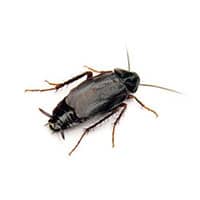
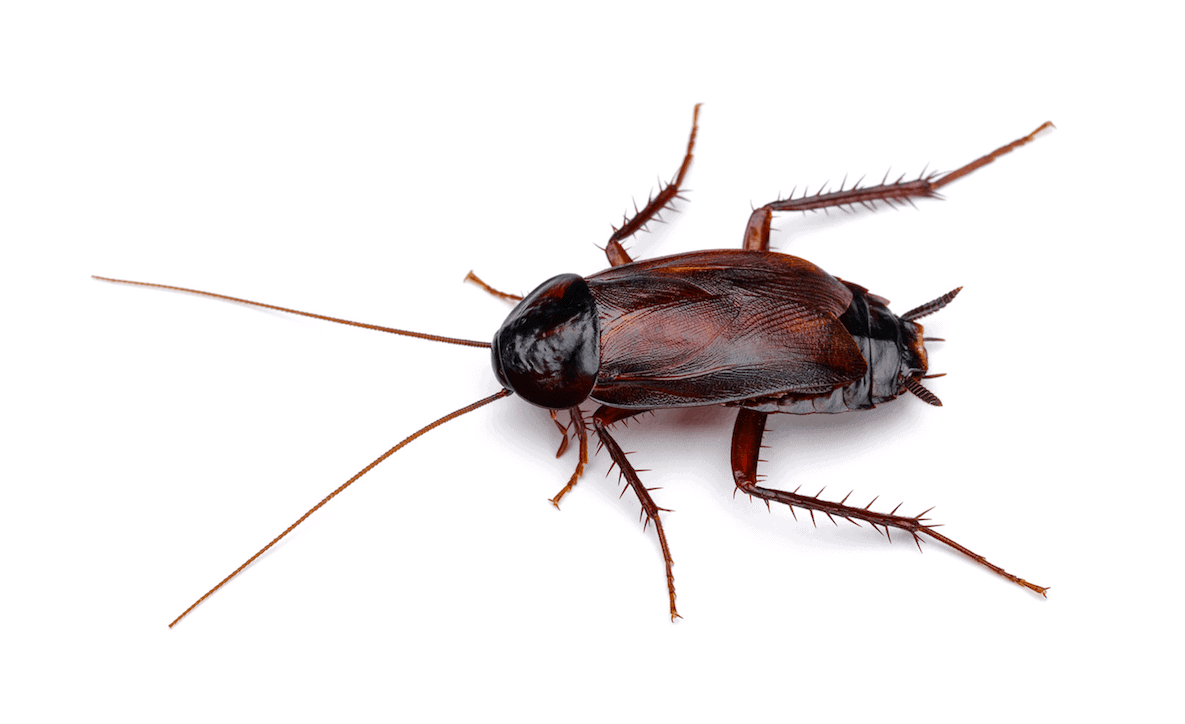
Shiny and very dark brown, nearly black in appearance. Nymphs may be reddish brown.
They are cold tolerant and are often found outside buildings, a factor which should be remembered when controlling them. Check cooler, dark, damp places. Inspect basements, waste storage areas, cellars, pipe ducts, storerooms, boiler houses, oven footings, floor cavities, brickwork, cracks in concrete, outbuildings, drains, rough ground, rubbish tips, gardens, sewers and external brickwork. Temperature preference is 20–29°C.
They are poor climbers on smooth surfaces, which may limit their distribution within a building.
The female Oriental cockroaches carry the ootheca for about 30 hours, after which time she deposits them, dropping or attaching them near a food source. Each ootheca contains 16 eggs which hatch in approximately six weeks, but this period may be greatly extended in cool conditions
Australian cockroach
Scientific name: Periplaneta australasiae.
Adult size: 25-35 mm
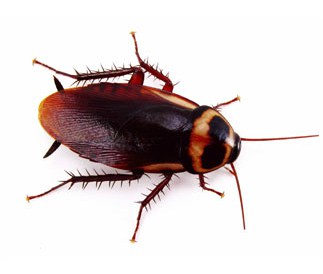
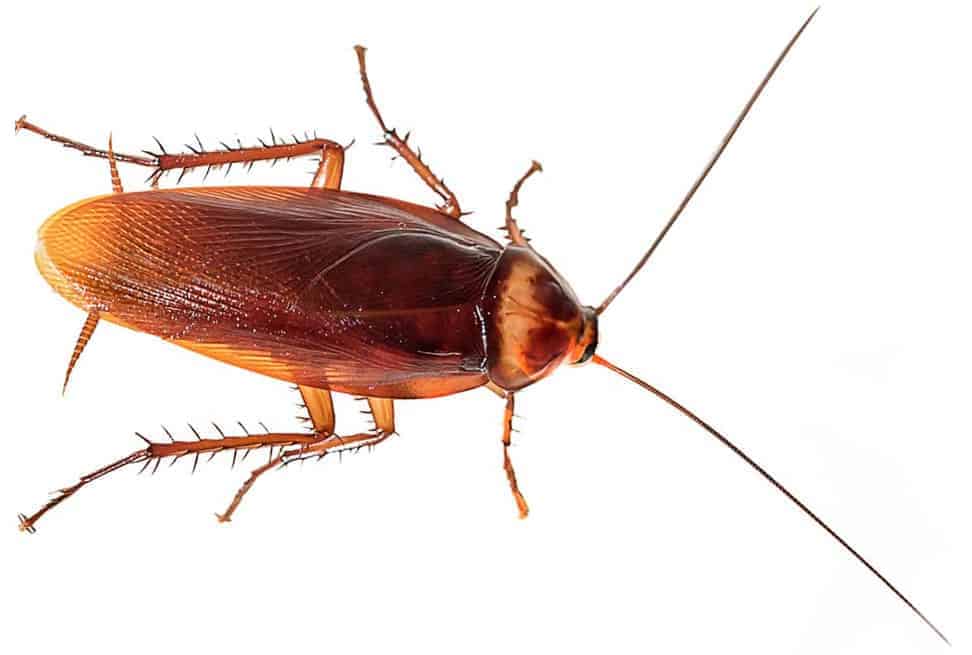
Adults are reddish brown, fully winged with a yellow to pale brown band around the pronotum and a yellow streak on the outer edge of the base of the front wings. Nymphs nearing maturity, have pale yellow markings on the lateral margins of the thorax and abdomen.
This species closely resembles Periplaneta Americana and requires hot, moist conditions to survive.
The Australian cockroach is found in tropical and sub-tropical areas of Australia and northern New Zealand.
They feed mainly on garden organic matter and waste but they will forage inside buildings and establish in garages, outbuildings, under floor areas and wall voids. These species are not usually found in sewers, unlike the American cockroach.
The female cockroach deposits the egg case containing around 16 eggs. These hatch in approximately 80 days.
How to get rid of cockroaches in restaurant kitchens
Chemical control alone will not get rid of cockroaches. A high level of hygiene is essential.
Exterior Cockroach Management
Neighbours’ activities around bins, gardening, recycling and composting may bring cockroaches to your area. Consider placing a sticky trap outside and monitor how many are coming in through your back door. If you think the cockroaches are heading to yours from across the way, it may require a team plan to stop the issue.
External drains and sullage pits and grease traps may be culprits. Consider using a bio-cleansing agent.
Minimise plants, mulch and leaf litter around buildings. Cockroaches often feed and develop in lawn clippings. They provide the ideal conditions as grass decomposes, producing heat, moisture and bacteria. Ensure grass clippings are put into sealed garbage bins, bags or proper sealed composting bins. Do not deposit grass clippings around plants.
Limit planting close to buildings particularly near to entrances.
Clear site of refuse. Remove accumulated equipment and rubbish around buildings.
Where practical, substitute the bright white mercury vapour globes with sodium vapour globes. They emit a softer, duller yellow light which is less attractive to cockroaches.
Ensure exhaust fans and ventilation outlets have insect mesh over the openings.
Screen windows and doors and minimise door opening times. Consider a self-closing door mechanism.
Seal off gaps around service pipes, electrical conduits, conveyor belts, roller doors and such in walls, eves and loading docks.
Interior Cockroach Management
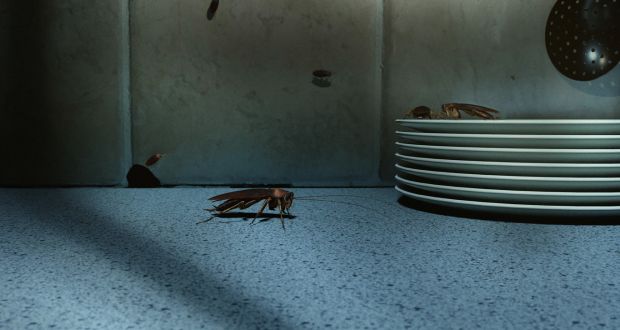
Cockroach in food restaurant
Daily clean-up of surfaces, floors, non-slip mats and waste is essential for cockroach control. Moisture leaks or damp areas must be corrected. Biological cleaning products based on beneficial microbes can remove organic residues that provide a potential food source.
Cracked or missing tiles, poor wall surfacing and badly maintained fittings provide shelter for cockroaches. Proofing and sealing of areas harbouring cockroaches can be done by the staff or maintenance personal. Check fixtures for small cracks and crevices and fill these. Close holes into the establishment from wall voids.
Small amounts of waste in drains, damp floor mops, dirty tea towels or dirty dishes can provide food for cockroaches. Close up drains. Cap drains which are not required for water management. Place baskets or inserts made of screened material in active drains to prevent entry by the American cockroach. Baits and dusts can also be used inside drain lip. Ensure that a regular program of thorough cleaning of internal drains is in place.
Open food storage containers or unwrapped goods will provide food for cockroaches. All food should be stored in closed containers or fridges. Keep all stored goods off the floor.
Is it necessary to track kitchen pests?
One way to go about pest management is to do the shotgun approach – tons of traps, pesticides, barriers etc. Not a very smart approach – you’re never sure what is working and what isn’t. This can be a big waste of time and money. A smart approach is to track your pest observations and concentrate your resources where needed. Tracking gives you a history to view and verify that a particular system is or isn’t working.
Harbourages – check the cracks and crannies
Cockroaches are nocturnal, foraging for food and water at night. They spend the day hiding in cracks and crevices and other hidden spaces.
They are notorious for leaving behind evidence. Look for droppings, shed skins and egg cases. A visual inspection to detect cockroaches can help uncover harbourages. Using a torch to shone into dark nooks and crannies. Flush out using a pyrethrum aerosol spray. Take care around pilot lights if using an aerosol.
Inspect trash bins, sinks, floor drains, kitchen equipment, wall voids, electrical outlets, electrical boxes, hollow tubing on appliance legs. Any crack, crevice or void where cockroaches may have taken up residence.
Night time monitoring may help. Sticky traps, left overnight near cockroach activity should produce results. Sticky trap monitoring of an area will indicate the extent of the problem and confirm the pest species.
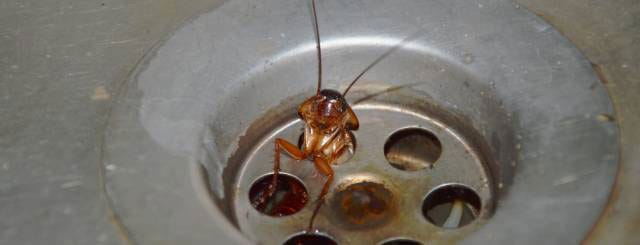
Cockroach in restaurant
DIY Restaurant Cockroach Control
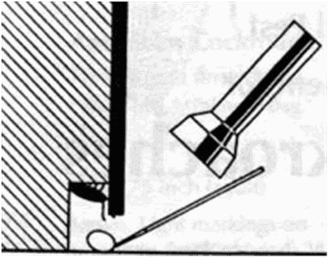
Cockroaches are nocturnal, so try to inspect at night. Use a flashlight and dental mirror to peek behind or under cabinets. Search for living or dead cockroaches, exoskeletons, egg cases and faeces.
Cockroaches have specific breeding and hiding places. It is important to target these during the control phase.
First inspect to locate breeding sites and hiding places using a torch and a food safe pyrethrum aerosol.
Look on the floor under and behind sinks, the stove, and other appliances. Peer behind and along the interior frame of cabinets and drawers, checking any voids. Examine the edges of drop ceilings, especially above cooking and dishwashing areas. Inspect the back of refrigerators.
Monitoring traps
Sticky cockroach traps with a pheromone lure attractant can catch foraging adults and nymphs. They can indicate infestations missed on visual inspections and flag problem areas. Sticky traps are useful for both short and long term monitoring.
Typically if you observe a pest at a location you would to put a trap there to see if that is a problem point.
- Put out sticky traps with a pheromone lure.
- Date and number the sticky traps for easy reference and monitor regularly.
- Identify traps on a site map to comply with your food safety management system. Draw a simple diagram of the restaurant or use a copy of the fire and evacuation map.
Place traps near evidence of cockroach activity and jot down the corresponding trap number on your diagram.
Download your pest monitoring sheet here.
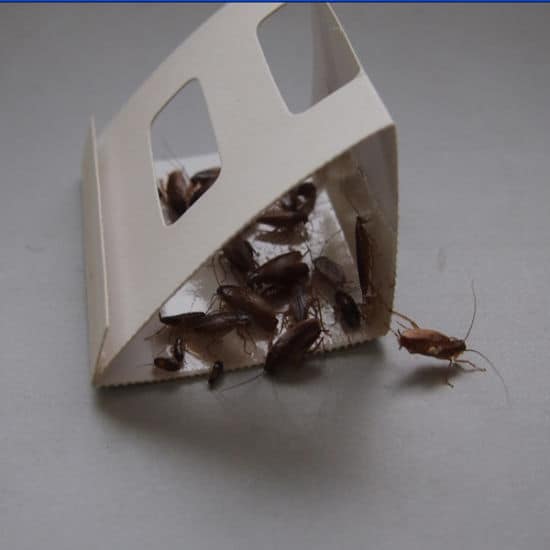
Baits and Gels
Cockroach baits and gels are designed as a palatable food source for cockroaches and have a delayed lethal effect. The bait is readily transferred and fed to other cockroaches. The male cockroach is the primary food gatherer. The female eats his faeces as a food source and passes it onto the young nymphs – spreading the bait throughout the entire population.
Baits may be in the form of gels, pastes, particles or bait stations. Baits are becoming increasingly useful in cockroach control and can offer safety advantages in commercial food-handling areas.
Baits and Gels are highly attractive to cockroaches and provides effective control, usually for months. Applied in small blobs in kitchen cupboards and other spots where cockroaches hide and forage. Avoid placing baits and gels in high traffic or frequently washed areas or on food preparation surfaces.
For German cockroaches, set bait stations next to cracks and crevices, or on the floor behind the stove or refrigerator. For the American roach, set bait stations in the basement near sewer or floor drains.
A regular baiting program can significantly reduce cockroach numbers. Confirm effectiveness and bait replacement by monitoring numbers of cockroaches killed.
Limitation: Bait and gels can be effective to control German roaches, which tend to congregate in warm, moist feeding and harbourage areas. However, the same does not apply to the larger species such as the American cockroach. These are more erratic and widespread in their feeding and harbourage behaviour.
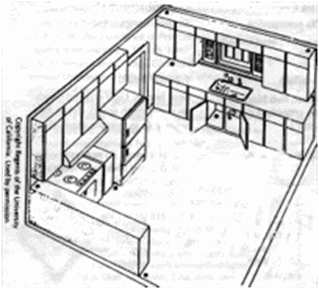
Keep Baits and gels out of high traffic areas.
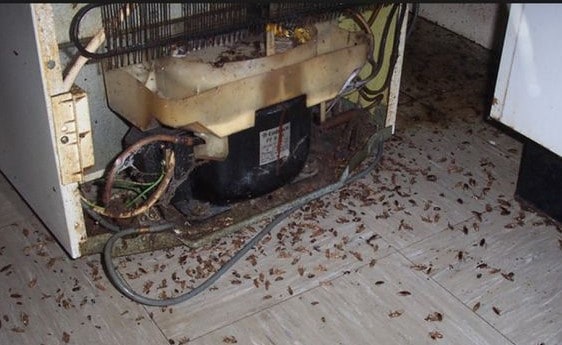
If cockroaches infest the insulation of a refrigerator, use a bait. Keep sprays away from all electrical equipment and motors.
Residual Insecticides
Cockroaches that walk over treated surfaces or stay in treated hiding places will be killed. Cockroaches congregate together and frequently groom themselves. This behaviour is exploited by pesticides. Residual products that contact their feet or body are ingested during grooming.
Apply spot treatments to areas where cockroaches walk or hide such as wall voids, back of fittings, below benches and backs of freezers. Select out of the way positions which will not come in contact with people, food or work surfaces.
Insecticidal dusts
Great in areas that cannot be treated with wet sprays. Dusts can be used to penetrate wall and roof voids and electrical equipment which could be damaged by wet sprays. Apply to cracks and crevices as well as wall and cabinet voids. Apply with care around electrical equipment. Dusts should always be applied lightly and carefully to avoid unnecessary contact.
Boric acid is a powder used in cracks. Cockroaches walk through it, attaching it to their body and eventually eat it. A light dusting is all you need. Buy a product with a nozzle so you can squirt it into a crack.
Insecticidal spray
A liquid spray is often required to gain effective control. Treatment of observed harbourages with residual insecticide can significantly reduce cockroach numbers. Indoors, treat such areas as skirting boards, bin recesses, base of doors, behind equipment and around the top of drains. Outside, spray the immediate external perimeters of building. (Also known as barrier spray) Give extra attention to the back door, loading dock and outside bin area. Around the building, consider treating if activity is suspected in garden mulch, retaining walls, drains, grease traps, sheds, garages and fence lines.
Space Treatments
Food safe pyrethrum insect spray in automatic dispensers. Multiple units are set up to treat indoor air spaces. Being airborne automatic spray dispensers are unlikely to penetrate the nooks and crannies. The spray will float in the air and repel all flying insects. These sprays are not a fast knockdown product. The spray is photo biodegradable, meaning it breaks down in light and air and does not settle on surfaces. Whilst ideally suited to fly control, automatic fly control units are a worthwhile preventative measure for cockroaches. Purchase food friendly space treatment aerosols and dispensers here.
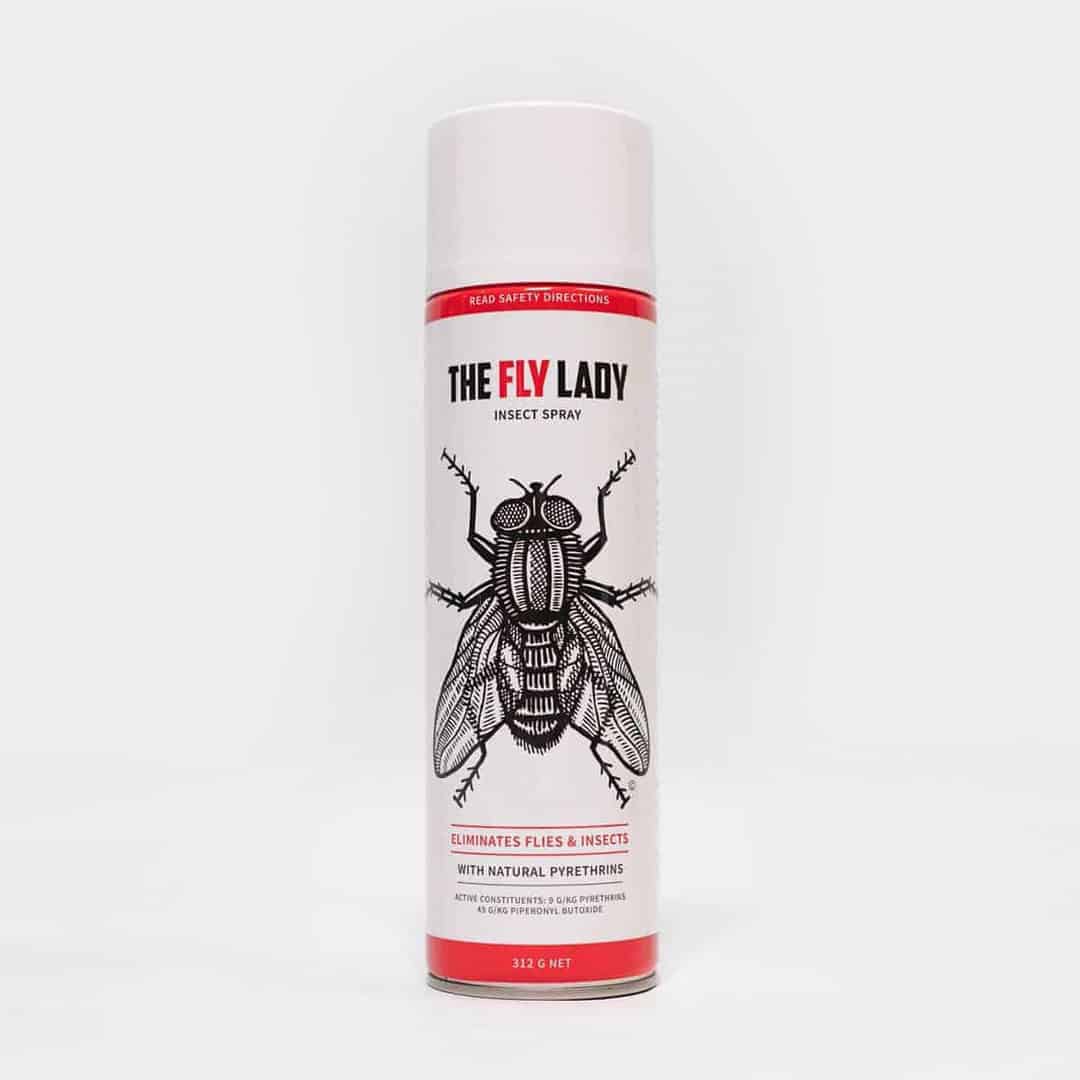
Food Approved Pyrethrum Aerosol Spray
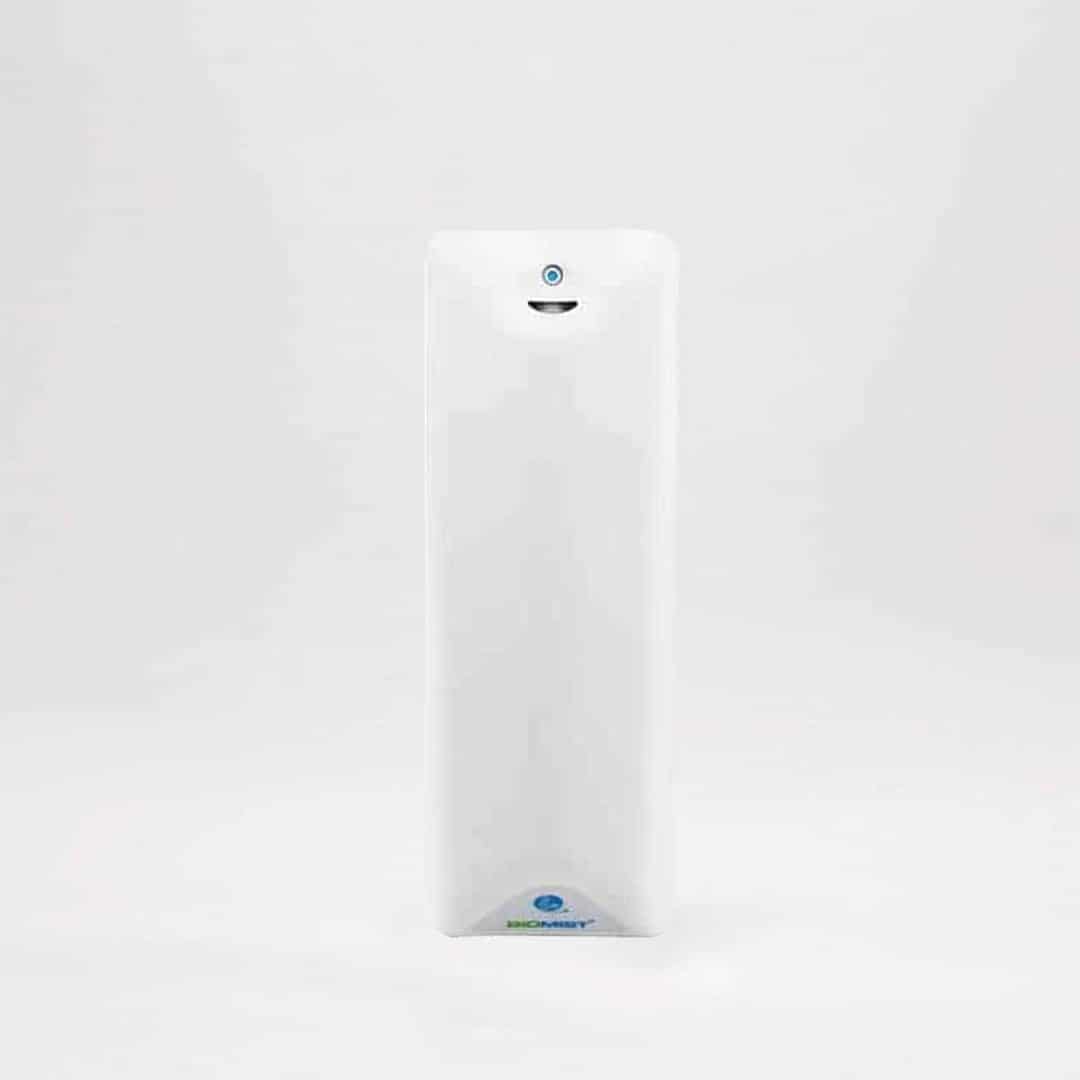
Automatic Dispenser
Heavy duty space treatments
Non residual, flushing, fast knockdown insecticides can be useful in heavy infestations. These can be applied via foggers or high-pressure aerosols and CO2 propellant cylinders. These need to be applied when the premises are vacated. Specific preparation, ventilation and clearance requirements are mandatory procedures during space treatments. No-entry periods and exclusion procedures are essential.
In conclusion
If you are considering managing your own cockroach control program you will likely require a monthly treatment especially during the summer months.
Application of pesticides to areas favoured by cockroaches may consist of any or a combination of methods. Use area appropriate products only – ie. food safe products in kitchens and always follow label instructions.
Please note that the effectiveness of chemical control may be limited by poor hygiene.

FAQ
How can I tell if I have a cockroach infestation?
Cockroaches leave behind lots of evidence. If you spot their droppings, smear marks, shell moults, egg cases or an unusual odour you can be sure there are cockroaches lurking.
How long do cockroaches survive without food?
Cockroaches can survive for up to a month without ingesting any food but will die without water in a week.
What is the lifespan of a cockroach?
Most cockroach species are known to have a lifespan around one year. This can vary, as environmental factors should be taken into consideration such as how harsh the weather conditions are and how abundant food and water is.
Do cockroaches fly?
Yes some species do fly. However, the commonly found ones like Oriental and German cockroaches do not fly.
How do cockroaches get into restaurants?
There are several ways cockroaches can get into restaurant kitchens. Most commonly, they are brought into buildings on products and deliveries. German cockroaches are effective “hitchhikers” and may hide in the incoming supplies, packing materials, cardboard boxes and pallets. Employees may carry cockroaches to work with them on their personal belongings.
Some cockroaches will travel between and enter buildings through drain and sewer pipes and underground utility lines. The sewers and floor drains can provide a never-ending route for cockroaches to enter the building unless the drain connection is appropriate.
Large cockroaches, such as American and Oriental species, can survive outdoors. Conducive conditions around buildings need to be evaluated and monitored to eliminate or reduce potential harbourage. Physical exclusion is a key management process to keep these species out of the business.
How do l record cockroach activity for my food safety records?
Record keeping can be kept simple.
- All traps need to be individually numbered.
- Traps are placed near sighted or suspected pest activity areas.
- Unique trap number is recorded on the venue site map.
- This map can be a simple hand drawn sketch. Alternatively, use a copy of the business evacuation plan.
- This plan, showing trap locations, is kept with the pest inspection report log where the specifics about each trap is documented.
Are cockroaches becoming immune to insecticides?
The short answer is yes. Prevention is a much better strategy than eradication — perhaps now more than ever. To read the article “Cockroaches Will Soon Be Immune to Insecticides” from the Australian food safety website click here
Must l use a pest controller in my restaurant?
In short, NO.
This answer from food authority nsw.
“If you perform pest control treatments yourself, make sure that any chemicals or baits used aresuitable and approved for use in food premises and do not contaminate food or food contactsurfaces.” Visit the Food Authority NSW Gov Au to read their pest control fact sheet.
What is 24/7 digital pest monitoring?
Becoming more common place in hospitals and larger sensitive environments.
Digital pest monitoring works as such.
- a sticky trap in a box
- a laser beam detects movement of pest entering the box
- movement triggers a photo from a tiny digital camera
- photo is automatically sent to nominated address.
Person monitoring the alerts know that action is required at that venue.
They are able to identify the species of pest responsible and take action.
Remote 24/7 digital monitoring. Pretty nifty
How do l know if a pest control product is safe to use in a restaurant kitchen?
The APVMA regulates all chemical labelling in Australia. Labels will specify where and how to use the product, rates of dilution and safety precautions. Always get the Medical safety data sheet for pest control products to keep with the your food safety records and display where appropriate staff can access. HACCP certified products can be suitable for use in food areas but again, follow the instructions.
Never decant chemicals as this increases chances of there being a mix up. Keep chemicals in original containers unless proper labels can be arranged. Always store in appropriate area away from the food space.